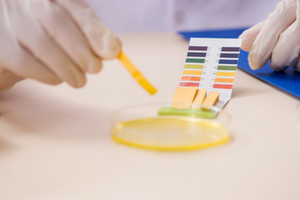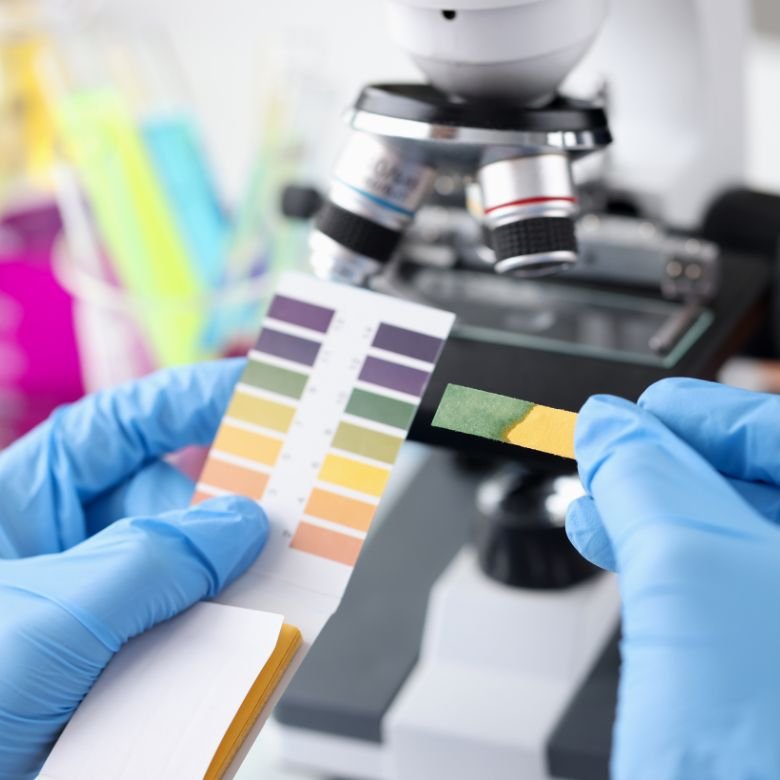If we know the pH value, we can establish the reaction of a given solution. A vast majority of chemical processes are carried out in a water environment. Consecutive compounds change their pH value as they decompose into ions. To determine that value, we usually use pH meters, but in practice the acid-base indicators continue to play a great role. They allow us to determine the solution’s reaction by visual inspection. So let’s learn more about them.

Definition of pH
As the definition indicates, pH is a negative logarithm of the concentration of hydrogen ions. In this case, we calculate that value using something that is called molar concentration. All chemical compounds can be classified based on the pH into those with acidic, basic or inert reaction (thus, the reaction is determined by the concentration of hydrogen ions). This is why the pH is often referred to as a measure of the acidity of a solution.
What do we need the pH value for?
- Specifying the reaction of a solution
- Predicting the possibility of a chemical reaction
- Ensuring appropriate conditions for certain plants
- Adjusting specific processes with the aim to treat industrial sewage
- Selecting efficient cleaning agents for the type of contamination
The pH value is intrinsically linked with the term pH scale. The scale ranges from 0 to 14. It is a very useful tool for organising solutions based on their chemical reaction. The pH scale is a negative logarithmic scale. It assumes that the solutions whose pH is:
- lower than 7 (<7) are acidic (characteristic of acid solutions),
- equal to 7 are inert,
- higher than 7 (>7) are basic (characteristic of base solutions).
The pH of extremely concentrated solutions may go below 0 or above 14, in other words, off the pH scale.
Acid-base indicators
pH indicators are specified chemical substances which turn a certain colour based on the environment. Their characteristic feature is that their colour is constant in a solution having a specified reaction; for instance, methyl orange is red in a highly acidic solution. In laboratories, we can most often see indicators that are weak organic acids or bases (acid-base indicators). The variability of their colour depending on the reaction is due to that fact that solutions also establish the equilibrium between the non-dissociated (colour A) and the dissociated (colour B) form of the compound. Based on the side to which the chemical equilibrium is shifted (that is, based on the content of hydrogen ions), a particular form prevails, having a specific colour.
Most popular pH indicators:
- Phenolphthalein – the most commonly used indicator in chemical laboratories. It is applied in the form of a 1% solution. It is colourless in neutral solutions, while in a basic environment it turns a characteristic raspberry colour.
- Methyl orange – it is used to detect acids, as in their presence it takes an intense red (pH < 3.2) or yellow (pH > 4.4) colour. It belongs to the group of the so-called azodyes. It is used as an aqueous solution.
- Bromocresol green – applied in most analyses of organic compounds. It is a solid with white to cream colour. It is yellow in acidic solutions and switches to blue when affected by a base.
- Methyl red – an azodye. It switches colour from dark red to yellow in the pH range from 4.2 to 6.3. It is mainly used in acid-base titration.
- Bromothymol blue – a derivative of thymol blue. The change of colour for this pH indicator ranges from yellow (acidic reaction) through green (neutral reaction) to dark blue (basic reaction).

Indicator papers
Acid-base indicators are often used in laboratories. However, they characterise in that they change colour within certain ranges of pH values, which may hinder the determination of an approximate pH value of a solution with an unknown composition.
A particularly effective solution is indicator papers. By mixing appropriate indicators, we obtain universal indicators, which are then applied on strips of simple filter paper. When dry, the resulting paper is our universal indicator paper.
Determining the pH value with universal indicator papers consists in immersing them in the test solution. The papers normally come with an appropriate colour scale. We compare the colour of the universal indicator paper to the colour on the scale, and in this way we determine the approximate pH value.
Home-made pH indicators
A range of naturally-occurring substances may be used as pH indicators. We can find many examples in the kitchens or garden. This proves the claim that chemistry literally surrounds us.
Tea
Most people certainly notice that when we add lemon juice to tea, the tea will get somewhat paler. This is because tea essence is a natural pH indicator. The addition of lemon juice causes the pH to decline, which changes the light brown colour (neutral reaction) into straw yellow (acidic reaction). That change of colour is caused by compounds called tannins, which are also responsible for the characteristic aftertaste of tea.
Beet juice
Beet juice is also distinguished by the variability of colours based on the reaction. In an acidic environment, its colour is red-and-violet, often referred to as purple. The colour can be observed, for example, when cooking beetroot soup. However, during preparation it loses its colour, especially if the temperature is too high. This is due to the thermal degradation of betaines during boiling. To restore the deep purple colour, we should acidify the stock, so add for example a small amount of citric acid.
Flowers
The dyes existing naturally in some flowers, e.g., in hydrangea or forget-me-nots, are also a sort of acid-base indicators. Their colour depends on the pH of the soil they grow in. Forget-me-nots are pink in acidic soils, while in a basic environment their colour is blue. It is similar with hydrangea: the lower is the pH value, the more flowers are blue and the more intensive that colour is.